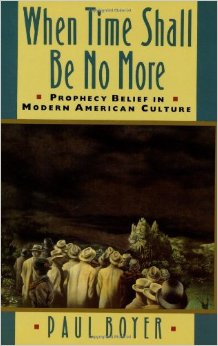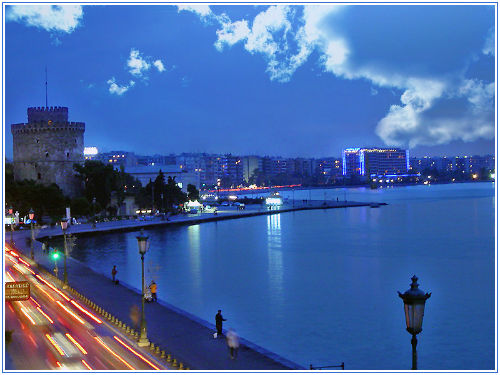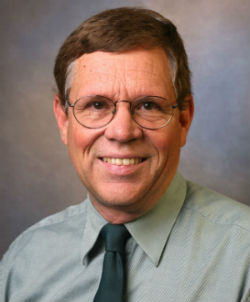 Historian Paul Boyer is an excellent and fair-minded source for debriefing all of us from overmuch prophetic speculation.
Historian Paul Boyer is an excellent and fair-minded source for debriefing all of us from overmuch prophetic speculation.By Neil Earle
 Historian Paul Boyer is an excellent and fair-minded source for debriefing all of us from overmuch prophetic speculation.
Historian Paul Boyer is an excellent and fair-minded source for debriefing all of us from overmuch prophetic speculation.The October 12 installment of the Los Angeles Times printed a dismissive review of a new movie titled “Left Behind” starring Nicholas Cage.
The movie’s theme is the sudden and secret disappearance of 2% of the world’s population in a supposedly dramatic “secret return” of Jesus Christ for his people. The idea – popularly known as “the rapture” from a Bible verse that means “taken up” – is purportedly based on Paul’s first letter to the Thessalonians, chapter 4 and verses 13 to 18. This, according to the theories of an Irish preacher named John Darby in 1830, is the way the elect of Christ will escape the coming Great Tribulation which Jesus alluded to in Matthew 24:21 but which many Christian thinkers believe was fulfilled in the destruction of Jerusalem by the Romans in 70 AD.
The Secret Rapture, which correctly proposes that the Returning Jesus will meet believers in the air, writes Glenn Whipp somewhat derisively, “offers chicken soup for the soul. You’ll be safe in heaven watching while those left behind are forced to choose whether to get the mark of the Beast tattooed on their forehead or on their hands” (LA Times, page D8, October 12, 2014).
Multiple millions of Christians believe in this rapture theory which takes its name from “harpazo” in 2 Thessalonians 4 (harpere in Latin meaning “to seize”) alluding to the saints being “caught up” to meet Jesus in the clouds. Rapture preaching has been a constant of end-time teaching since Darby first propounded it in 1830. The latest reboot is based on evangelist Tim LaHaye and author Jerry B. Jenkins “Left Behind” series of novels based on the fairly standard scenarios of the end. These novels have sold 65,000,000 copies!
But does this idea of the sudden secret disappearance of millions of people hold up to scrutiny? Is it feasible to believe in what the Times describes as “driverless cars careening into crowds, airplanes falling from the sky, true believers being sucked into the heavens?”
Too many good Christian people believe this idea to make light of it. So what is the best way to approach it?
 Salonika, Biblical Thessalonica, still a thriving seaport with a thriving Christian population. Paul came here about 49 AD.
Salonika, Biblical Thessalonica, still a thriving seaport with a thriving Christian population. Paul came here about 49 AD.Well, obviously we need to take a second look at St. Paul’s First Letter to the Thessalonians. But let’s start not in 1 Thessalonians 4:13-18 but in the book of Acts 17:1-11. This chapter describes Paul’s missionary visit to what we call Salonika today, a thriving city both then and now in Northern Greece.
Conditions for the early church in Thessalonica were grim indeed. Hostile persecutors forced Paul and Silas to hide out for their lives while some brethren were brought by a crazed mob before the authorities before being let go. The city was in an uproar over Christian teaching and when Paul wrote to the brothers in Thessalonica later on – perhaps around 50-51 AD – he dwelt on the fact that they had just suffered “much affliction” and that some of them had died (1 Thessalonians 1”6; 4:13).
This is key to understanding the misconception that haunts the Rapture teaching. Paul was writing a letter of comfort to show the Christians there that the faithful dead they were mourning were not gone for ever. Paul specifically states in these so-called Rapture verses that the Christian dead are in a privileged position. He states in 1 Thessalonians 4:16 that at the great resurrection of the just “the dead in Christ will rise first.”
Thus, rather than creating some kind of radical distinction between believers and the rest of the world, Paul is teaching the ultimate unity of all those who are in Christ.
 Methodist teacher Ben Witherington III keeps abreast of Biblical history and archaeology.
Methodist teacher Ben Witherington III keeps abreast of Biblical history and archaeology.The key event is Jesus’ dramatic second coming, rapturists are right about that, but this coming will not be secret. Hardly. Paul specifically says it will be a public, noisy dramatic event: “For the Lord himself will come down from heaven with a loud command, with the voice of the archangel, and with the trumpet call of God, and the dead in Christ will rise first” (1 Thessalonians 4:16).
Nothing secret about that. Those Christians still alive at Christ’s coming will be changed, given glorified bodies, even as the faithful dead are raised from their graves. Then both groups – the living and the dead – will meet Jesus in the air. The air is the traditional designation Paul used to describe the domain of Satan (Ephesians 2:2). By saying we meet Him in the air it indicates yet again that Jesus comes to put down all rule and authority beginning with the hostile factions in the spirit world (See John Stott’s The Gospel and the End of Time, page 104). Satan is preempted.
Paul is very definite about all this. It permeates all his teaching on the end times. The word he uses here and elsewhere for “coming” is Parousia which refers to a royal or state official coming to certain town, his herald going before him blowing a trumpet or announcing his parousia with a loud voice. Then the populace came out to meet the dignitary and escort him back into the city (See Ben Witherington’s Jesus, Paul and the End of the World, pages 157-158).
Here then is another problem with the Rapture Theory. When Paul concludes that “we will be with the Lord forever,” he is not indicating yet another return of the Lord to take up kingly rule. He is not talking about Christians being lifted off to heaven and escaping the bad things on this earth. (We could add that Paul is consistent in teaching that Christians must go through much tribulation to enter the Kingdom of God – Acts 14:22). Many other passages show Jesus descending to this earth and bringing about the Judgment of the Nations mentioned in Matthew 25. The New Jerusalem does come down out of heaven to this earth.
So there are at least three problems with the Rapture teaching as it is commonly taught and misunderstood. It is not secret, it is a message of comfort teaching the unity of God’s people living and the dead, and it ties in with many other passages that depict Jesus’ coming to be personal, vivid and visible.
What keeps this idea alive?
It bothers many Christian teachers that the Rapture arrives so late in church history. None of the early church fathers or reformers taught it. Even the LA Times can understand what gives the teaching its longevity. It is tied to the way world events often present a “bad news” scenario so depressing as to strike fear into many hearts.
“The Rapture genre trades on fear, and fear can be an effective tool in the short-term,” says Professor Craig Detwiller of Pepperdine University, a script writer and Christian film critic. Glenn Whipp agrees. “People crave certainty in anxious times. And we’re living in days when there’s a little something for Nervous Nellies of all stripes. Recession. Depression. Ebola. Obama. Drought. The Cloud…[and] a primal dread far greater: the fear of being separated from your family.”
But Christianity trades on hope not fear. One day Jesus will indeed return and that will be good news for all of God’s people and eventually for the whole world. That’s the great promise inherent in the Gospel, “of the increase of his kingdom and peace there shall be no end” (Luke 1:33). Many of the Rapture’s inventors and promoters seem to be well-meaning and even effective Christian teachers and they are right to keep people focused on the dire necessity of Jesus’ return. But there are flank weaknesses in the way the Second Coming is presented through the Secret Rapture that is actually searing and off-putting when promulgated a certain way. “These New Testament passages were meant to offer hope to people living under Roman oppression," says Lutheran scholar Barbara Rossing. ”It was about empowerment not escaping...I guess it speaks to our fascination with disasters. “
In First Thessalonians Paul gives many precious insights into our death and resurrection. He meant to confirm the Christian hope of the ultimate reward and reunion of all believers past and present. That means the message of the lively little book called First Thessalonians still needs to be preached today, no strings attached.
(For further reading see Paul Boyer’s “When Time Shall Be No more: Prophecy Belief in Modern American Culture” (Harvard University Press, 1992.)